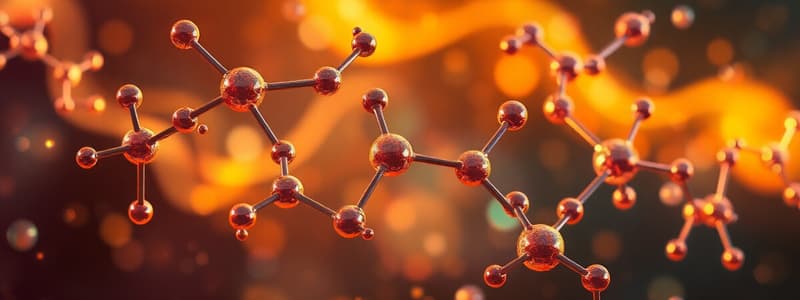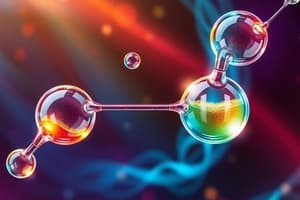Podcast
Questions and Answers
What is the role of the carboxylate ion in relation to carboxylic acid?
What is the role of the carboxylate ion in relation to carboxylic acid?
- It acts as a catalyst for carboxylic acid reactions.
- It is an unrelated byproduct of carboxylic acid.
- It is the conjugate base of carboxylic acid. (correct)
- It is the conjugate acid of carboxylic acid.
At which pH level is carboxylic acid 50% ionized?
At which pH level is carboxylic acid 50% ionized?
- pH = pKa - 1
- pH = pKa + 1
- pH = pKa (correct)
- pH = pKa + 2
How does increasing the pH affect the fraction of carboxylic acid that is ionized?
How does increasing the pH affect the fraction of carboxylic acid that is ionized?
- It decreases the fraction of ionized acid.
- It has no effect on ionization.
- It causes complete ionization of acid.
- It increases the fraction of ionized acid. (correct)
What is the mathematical expression for the fraction of HA ionized?
What is the mathematical expression for the fraction of HA ionized?
Which percentage of HA is ionized at a pH equal to pKa + 2?
Which percentage of HA is ionized at a pH equal to pKa + 2?
Which types of reactions can carbonyl groups undergo?
Which types of reactions can carbonyl groups undergo?
What is the general structure of a carbonyl group?
What is the general structure of a carbonyl group?
What is the bond angle between the σ bonds in a carbonyl group?
What is the bond angle between the σ bonds in a carbonyl group?
Which of the following is a correct statement regarding carboxylic acids?
Which of the following is a correct statement regarding carboxylic acids?
What contributes to the higher acidity of carboxylic acids compared to alcohols?
What contributes to the higher acidity of carboxylic acids compared to alcohols?
Identify which of the following compounds is a carboxylic acid.
Identify which of the following compounds is a carboxylic acid.
Which compound is least likely to undergo nucleophilic addition reactions?
Which compound is least likely to undergo nucleophilic addition reactions?
What is a key characteristic of hydrogen bonding?
What is a key characteristic of hydrogen bonding?
What is true about the C=O bond compared to the C=C bond in alkenes?
What is true about the C=O bond compared to the C=C bond in alkenes?
Which type of carbonyl compound is characterized by the presence of a halide?
Which type of carbonyl compound is characterized by the presence of a halide?
Which of the following compounds is a lactam?
Which of the following compounds is a lactam?
What type of reaction does an ester undergo to form a carboxylic acid?
What type of reaction does an ester undergo to form a carboxylic acid?
What type of carbonyl compound is a cyclic ester?
What type of carbonyl compound is a cyclic ester?
Which type of amide is characterized by having two carbon substituents on the nitrogen?
Which type of amide is characterized by having two carbon substituents on the nitrogen?
What effect do electron-withdrawing groups (EWG) have on the acidity of carboxylic acids?
What effect do electron-withdrawing groups (EWG) have on the acidity of carboxylic acids?
How do electron-donating groups (EDG) affect the carboxylate ion's willingness to lose a hydrogen ion?
How do electron-donating groups (EDG) affect the carboxylate ion's willingness to lose a hydrogen ion?
Which carboxylic acid has the highest acidity based on the provided pKa values?
Which carboxylic acid has the highest acidity based on the provided pKa values?
What determines the class of carboxylic acid derivatives?
What determines the class of carboxylic acid derivatives?
In nucleophilic acyl substitution reactions, which derivative is the most reactive?
In nucleophilic acyl substitution reactions, which derivative is the most reactive?
Which compound is considered a weak nucleophile and requires activation by acid catalysis?
Which compound is considered a weak nucleophile and requires activation by acid catalysis?
How does protonation of the carbonyl oxygen affect the carbonyl carbon?
How does protonation of the carbonyl oxygen affect the carbonyl carbon?
What is the Bürgi-Dunitz angle relevant to?
What is the Bürgi-Dunitz angle relevant to?
Which characteristic makes a carbonyl compound more susceptible to nucleophilic attack?
Which characteristic makes a carbonyl compound more susceptible to nucleophilic attack?
What role do thioesters play in biological processes?
What role do thioesters play in biological processes?
Which of the following statements about carboxylic acid hydrolysis is correct?
Which of the following statements about carboxylic acid hydrolysis is correct?
What is the result of increasing the number of Cl atoms on a carboxylic acid?
What is the result of increasing the number of Cl atoms on a carboxylic acid?
Which of the following compounds exists primarily in a hydride form only under extreme conditions?
Which of the following compounds exists primarily in a hydride form only under extreme conditions?
Flashcards
Carboxylate ion
Carboxylate ion
The negatively charged form of a carboxylic acid, formed by the loss of a proton (H+). It has a characteristic resonance structure with a negative charge delocalized between the two oxygen atoms.
Acid Dissociation Constant (Ka)
Acid Dissociation Constant (Ka)
A measure of the acidity of a weak acid. It reflects the equilibrium constant of the dissociation of the acid into its conjugate base and a proton.
pKa
pKa
The pH at which a weak acid is 50% ionized, meaning half of the acid molecules are in their undissociated form (HA) and half are in their ionized form (A-).
Fraction Ionized
Fraction Ionized
Signup and view all the flashcards
Fraction Ionized - pH Dependency
Fraction Ionized - pH Dependency
Signup and view all the flashcards
Aldehyde
Aldehyde
Signup and view all the flashcards
Ketone
Ketone
Signup and view all the flashcards
Carboxylic Acid
Carboxylic Acid
Signup and view all the flashcards
Acyl Halide
Acyl Halide
Signup and view all the flashcards
Ester
Ester
Signup and view all the flashcards
Anhydride
Anhydride
Signup and view all the flashcards
Lactone
Lactone
Signup and view all the flashcards
Amide
Amide
Signup and view all the flashcards
Thioester
Thioester
Signup and view all the flashcards
Nitrile
Nitrile
Signup and view all the flashcards
Hydrogen Bonding
Hydrogen Bonding
Signup and view all the flashcards
Acidity
Acidity
Signup and view all the flashcards
Acidity Constant (Ka)
Acidity Constant (Ka)
Signup and view all the flashcards
Resonance Stabilization
Resonance Stabilization
Signup and view all the flashcards
Effect of Electron-withdrawing Groups on Carboxylic Acid Acidity
Effect of Electron-withdrawing Groups on Carboxylic Acid Acidity
Signup and view all the flashcards
Effect of Electron-donating Groups on Carboxylic Acid Acidity
Effect of Electron-donating Groups on Carboxylic Acid Acidity
Signup and view all the flashcards
Carboxylic Acid Derivatives
Carboxylic Acid Derivatives
Signup and view all the flashcards
Reactivity of Carboxylic Acid Derivatives
Reactivity of Carboxylic Acid Derivatives
Signup and view all the flashcards
Interconversion and Hydrolysis of Carboxylic Acid Derivatives
Interconversion and Hydrolysis of Carboxylic Acid Derivatives
Signup and view all the flashcards
Polarity and Electrophilicity of the Carbonyl Group
Polarity and Electrophilicity of the Carbonyl Group
Signup and view all the flashcards
Activation of Carbonyl Compounds
Activation of Carbonyl Compounds
Signup and view all the flashcards
Nucleophilic Attack on Carbonyl Compounds
Nucleophilic Attack on Carbonyl Compounds
Signup and view all the flashcards
Reversibility of Nucleophilic Addition Reactions
Reversibility of Nucleophilic Addition Reactions
Signup and view all the flashcards
Nucleophiles in Carbonyl Chemistry
Nucleophiles in Carbonyl Chemistry
Signup and view all the flashcards
Bürgi-Dunitz Angle
Bürgi-Dunitz Angle
Signup and view all the flashcards
Biological Carboxylic Acid Derivatives
Biological Carboxylic Acid Derivatives
Signup and view all the flashcards
Acetyl Coenzyme A (Acetyl-CoA)
Acetyl Coenzyme A (Acetyl-CoA)
Signup and view all the flashcards
Adenosine Triphosphate (ATP)
Adenosine Triphosphate (ATP)
Signup and view all the flashcards
Nucleophilic Carboxyl Substitution in Biological Systems
Nucleophilic Carboxyl Substitution in Biological Systems
Signup and view all the flashcards
Study Notes
MPharm Programme - PHA114 Carbonyl Compounds 1
- Carbonyl compounds have a carbonyl group (C=O)
- Many different kinds of carbonyl groups exist
- Carbonyl groups can undergo various reactions, including nucleophilic addition reactions (aldehydes and ketones), nucleophilic addition elimination reactions, and reactions with carboxylic acid derivatives.
- Examples of carbonyl compounds include aldehydes, ketones, acyl halides, anhydrides, esters, lactones, amides, lactams, thioesters, mono phosphates, nitriles.
- Chemical structures of different carbonyl compounds are illustrated.
- Specific examples of drug molecules containing carbonyl groups are shown, including Procaine, Lidocaine, Cocaine, Captopril, Enalapril, Penicillin N, Erythromycin, Vincristine, Podophyllotoxin, and Dactinomycin.
- Carbonyl structure includes trigonal planar sp² carbon and oxygen, C-O σ bond between sp² orbitals, σ bonds lie in the same plane (~120° apart), C-O π bond between parallel p orbitals.
- The C=O bond is shorter, stronger, and more polar than a C=C bond in alkenes. Data about bond length and energy provided.
- Hydrogen bonding is crucial for drug-receptor interactions.
- Carboxylic acids are weak acids that donate protons to water.
- Carboxylic acids transfer a proton to water, generating H3O+ and carboxylate anions.
- The acidity constant, Ka, ranges from 10⁻³ to 10⁻⁵ for typical carboxylic acids.
- pKa values for most aliphatic and aromatic carboxylic acids fall between 3 and 5.
- The acidity of carboxylic acids is higher than alcohols due to resonance stabilization of the carboxylate anion.
- The fraction of a weak acid (HA) that is ionized is dependent on the pH and pKa.
- The ionization of a compound is greatest at a pH near its pKa (50%).
- Electron-withdrawing groups (EWGs) increase carboxylic acid acidity by stabilizing the negative charge on the carboxylate anion. Examples include halogens.
- Electron-donating groups (EDGs) decrease carboxylic acid acidity by destabilizing the negative charge on the carboxylate anion.
- Carboxylic acid derivatives (acid chlorides, anhydrides, esters, amides) can be interconverted via nucleophilic acyl substitution reactions and can be hydrolyzed to the parent carboxylic acid.
- Thioesters and acyl phosphates are common in biological systems as intermediates in metabolic reactions.
- The carbonyl group is polar (oxygen being more electronegative), and the carbonyl carbon is electrophilic, making it susceptible to nucleophilic attack.
- Protonating the carbonyl oxygen makes the carbonyl carbon even more electrophilic.
- Nucleophiles (negatively or positively charged species) readily attack the carbonyl carbon when conditions are favorable.
- Reversibility of reactions at the carbonyl group can occur under acidic or basic conditions.
Studying That Suits You
Use AI to generate personalized quizzes and flashcards to suit your learning preferences.




